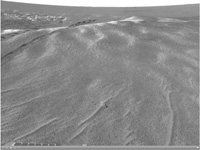Looking Back at ‘Eagle Crater’(Right-eye)
Caption:

Click on the image for Looking Back at 'Eagle Crater' (QTVR)
This is the right-eye version of the first 360-degree view from the Mars Exploration Rover Opportunity's new position outside "Eagle Crater," the small crater where the rover landed about two months ago. Scientists are busy analyzing Opportunity's new view of the plains of Meridiani Planum. The plentiful ripples are a clear indication that wind is the primary geologic process currently in effect on the plains. The rover's tracks can be seen leading away from Eagle Crater. At the far left are two depressions -- each about a meter (about 3.3 feet) across -- that feature bright spots in their centers. One possibility is that the bright material is similar in composition to the rocks in Eagle Crater's outcrop and the surrounding darker material is what's referred to as "lag deposit," or erosional remnants, which are much harder and more difficult to wear away. These twin dimples might be revealing pieces of a larger outcrop that lies beneath. The depression closest to Opportunity is whimsically referred to as "Homeplate" and the one behind it as "First Base." The rover's panoramic camera is set to take detailed images of the depressions today, on Opportunity's 58th sol. The backshell and parachute that helped protect the rover and deliver it safely to the surface of Mars are also visible near the horizon, at the left of the image. This image was taken by the rover's navigation camera.
Cataloging Keywords:
| Name |
Value |
Additional Values |
| Target |
Mars |
|
| System |
|
|
| Target Type |
Planet |
|
| Mission |
Mars Exploration Rover (MER) |
|
| Instrument Host |
Opportunity (MER-B) |
|
| Host Type |
Rover |
|
| Instrument |
Navigation Camera (Navcam) |
|
| Detector |
|
|
| Extra Keywords |
Crater, Grayscale |
| Acquisition Date |
|
| Release Date |
2004-03-23 |
| Date in Caption |
|
|
| Image Credit |
NASA/JPL |
| Source |
photojournal.jpl.nasa.gov/catalog/PIA05620 |
| Identifier |
PIA05620 |

 Planetary Data System
Planetary Data System

